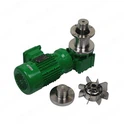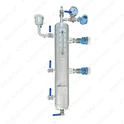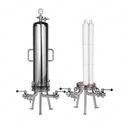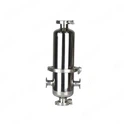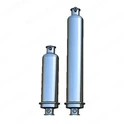The preparation of wort, is the most important step in beer brewing process and is also the important premise and basis for fermentation.Sometimes some new craftsmen are unfamiliar with the procedure in the beer brewing process, so they will be busy, lost etc., which seriously affect the quality of wort preparation.
Today, I have compiled a copy of the "Saccharification Process Operating Procedures" about the beer brewing process for everyone to learn and reference, developing standardized work habits together.
Saccharification Process

Operation Process
Malt crushing
1)Inspection of the malt. According to the requirements of saccharification process ingredients, check whether the variety, quantity and quality of malt meet the process requirements.
2)Weigh the malt. According to the requirements of saccharification process ingredients, accurately weigh. After weighing, seal the remaining malt and return it to the original storage point.
3)Start the grinder. Start the grinder in accordance with the "Operating Regulations of the grinder".
4)Begin to powder malt. After the grinder is running normally, start feeding and crushing the malt. During the crushing process, check the pulverization degree of the malt according to the process requirements. After the crushing, let the grinder continue to run for about 1 minute to ensure that the malt between the rollers of the grinder is smashed cleanly without accumulation. Turn off the grinder.
5)Clean up the environment. Clean the crushing environment and put the crushing aids back in place.
Saccharification
1)Equipment inspection. Check and confirm the saccharification equipment, pipelines, valves, water supply, steam supply, etc. before feeding, and then feeding after everything is ready.
2)Feeding. Before feeding, add the feeding saccharification water to the saccharification pot according to the process requirements, and turn on the saccharification stirring, and then start feeding the saccharification pot and record the time.
3)Protein rest. Turn off the stirring after 1 minute after the feeding, and rinse the dust on the inner and outer walls of the pot; adjust the temperature of the mash to keep it warm for protein decomposition, stand still according to the process requirements, and record the time.
4)Saccharification. After the protein decomposition is over, start stirring and heating, adjust to the specified saccharification temperature in the process, stand still, and saccharification according to the required time of the process. Before the end of saccharification, perform an iodine test and record the time.
Wort filtration
1) Equipment inspection. Check again to make sure that the filtering equipment, pipelines, valves, etc. are all right. Then pour bottom water at a suitable temperature for the filter tank, paying special attention to whether the drain outlet is well closed.
2)The mash is pumped into the filter tank. Turn on the stirring, raise the temperature to the enzyme-killing temperature according to the process requirements, and pump the mash into the filter tank. After the mash has been pumped into the filter tank, stay still, and record the time.
3)Wort filtration. Before starting the filtration of the wort, reflux for 5-10 minutes or until the wort is clear and transparent, and then filter the wort to the prerum vessel; when the top wort is filtered about 1/2, take a sample to measure the concentration of the top wort. Estimate the total amount of mixed wort based on the concentration and quantity of the top wort, and record the time.
4)Grains Washing. When the top wort is filtered to the point of exposing the grains layer, start to add grains washing water to wash the grains. The amount, temperature, and residual sugar of the spent grains should be implemented according to the process requirements. After the filtration is completed, stop the wort pump and record the time.
5)Discharge of grains. After the wort pump is stopped, open the drain valve to discharge water and grains, finally rinse the remaining grains with water, close the drain valve and the drain outlet, and return to the standby state.
Wort Boiling
1)Equipment inspection. Check that all the boiling equipment, pipes, valves, etc. are OK.
2)Wort Boiling.After the equipment is confirmed to be ready, pump the wort into the boiling pot, start to boil the wort, and record the time. At the same time, take samples to measure the wort concentration, add hops, etc. according to the process requirements, and record the time.
Wort swirling
After the wort is boiled, take a sample to measure the concentration of the wort.Pump into the vortex sedimentation tank and stand still for the time required by the process, and check whether the vortex sedimentation tank is in a normal state before pumping into the tank.
Wort cooling
1)Before the wort is pumped into the cooling system, the thin plate and wort pipeline must be sterilized with hot water higher than 90℃ for 20 minutes according to the requirements of the operation process, and then the wort can be passed through.
2)cool down. When the temperature of the thin plate drops to the temperature required by the process, open the wort outlet valve and inlet valve, and start the wort pump to start wort cooling; 5 minutes after the wort has passed, turn on and controll the flow of oxygenation. During the process of wort cooling, close all valves that are not related to the feeding, and observe the wort temperature at any time, and control the pump speed and valve opening according to the temperature.
3)When the wort passing is over, stop the wort pump, turn off the wort outlet valve, then turn off the cold water pump and cold water outlet valve, turn off the oxygen, and record the time.
1)The vortex sedimentation tank flushing. Open the drain valve of the vortex sedimentation tank, drain the hops and hot coagulum, rinse the sedimentation tank, and close the drain valve.
2)Thin plate system cleaning. After the feeding is over, then topping the pipe wort, Washing thin plate and wort pipe to clean according to the process requirements of hot water, washing time.
The saccharification system, thin plate system, and saccharification pipeline system are cleaned according to the process requirements, and then the hot water flushes the system to clean (pH neutral).

